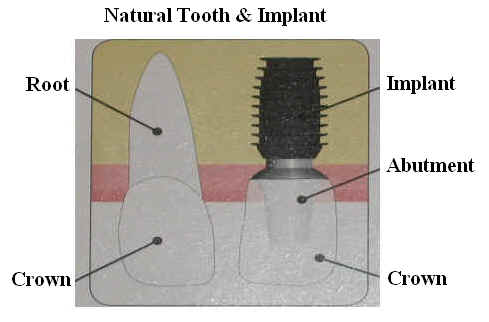 |
Dental Education Lecture: Introduction to Implant
 |
In last lecture, we mention that addition of two implants to an existing lower denture can help denture stability. We mention a part associated with implant, called abutment. In this lecture, an illustration (on your right side) is used to compare a natural tooth and an implant. Our tooth has two major portions: crown and root. The crown is exposed in the mouth for cutting and chewing, whereas the root is inserted inside the jaw bone (yellow). The portion between the crown and root is called neck (not shown). The neck passes through the gums (pink). Similarly, an implant apparatus is composed of three parts: implant itself, abutment and crown. In fact, implant functions as our root. To have a new artificial crown, we need to insert an abutment into the implant and passes through the gums and leave a stump in the mouth.
For implant to function, we basically need two procedures. In the first procedure, a surgeon makes a small incision over the gums of a missing tooth, inserts an implant and sutures up. Please read instructions after implant placement. We need to wait 1-4 months for the bone to heal and bind to the implant. This process is called osteointegration. In the second procedure, the doctor re-opens the gums, places an abutment, and probably makes a temporary crown. The second procedure is also called uncovering. Instructions after uncovering can be checked out here. Once the gums around the abutment heal, we can take final impression for a permanent crown. Contrary to our thinking, implant procedures are very gentle, causing minimal discomfort. Majority of patients are satisfied with final product. Do you want to see a real implant and know what we should do before implant placement? See you then.
Xin Wei, DDS, PhD, MS 1st edition 02/14/2009, last revision 09/28/2012